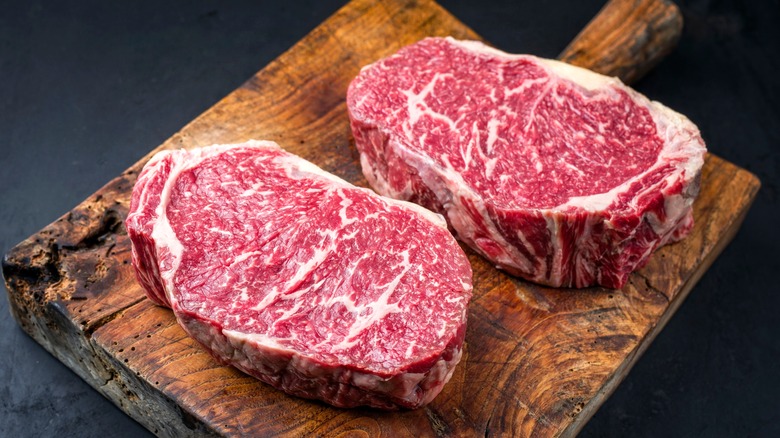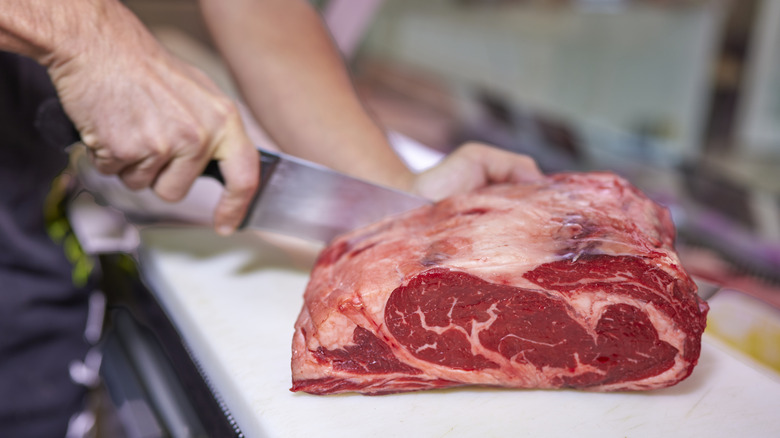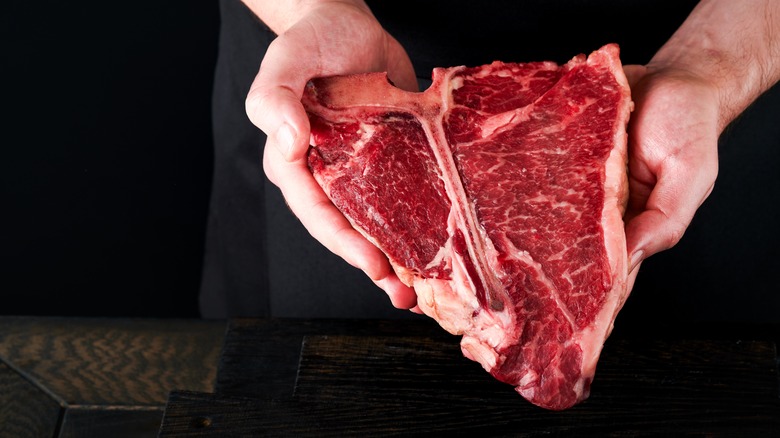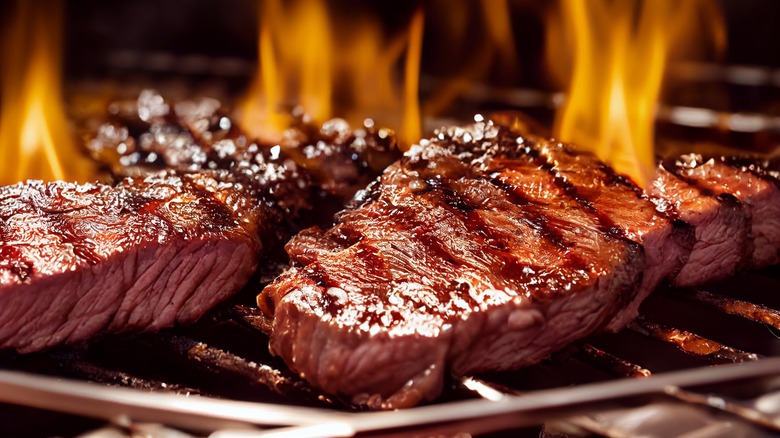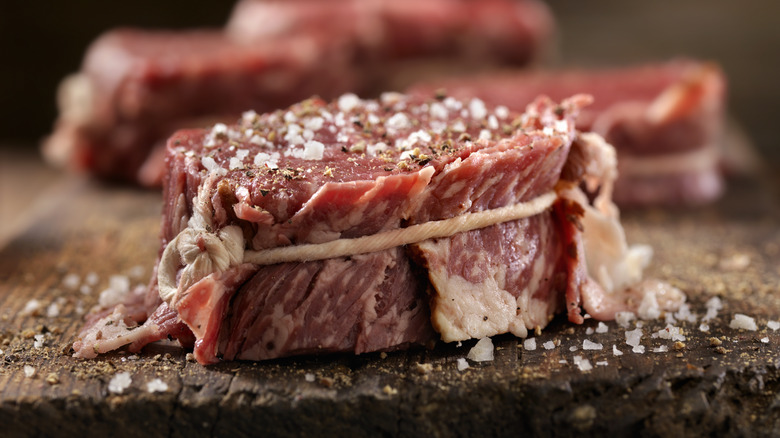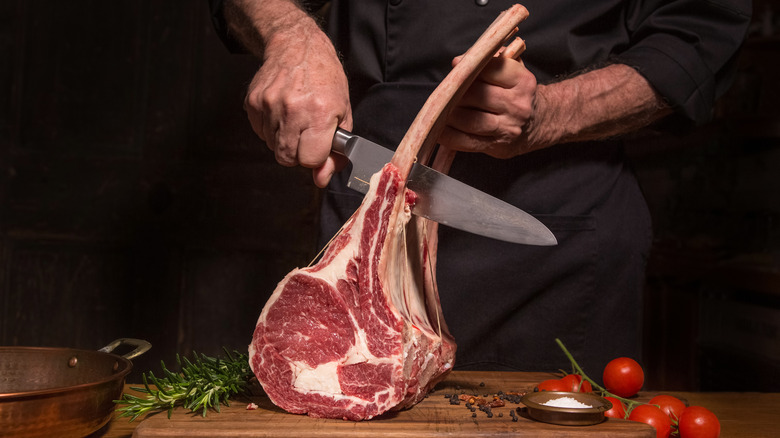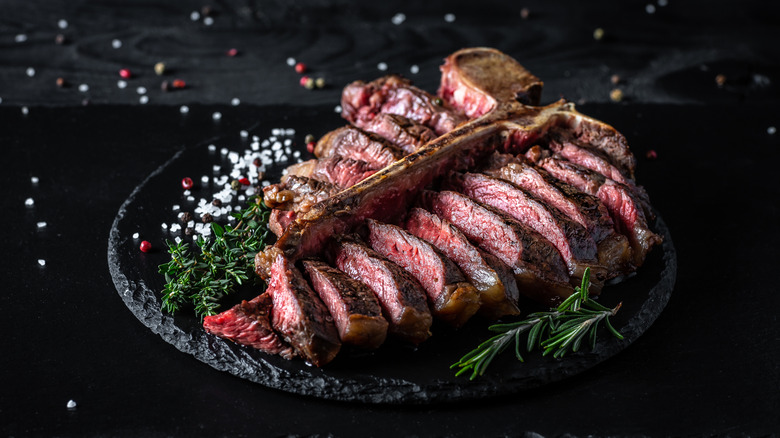What Are Hand-Cut Steaks And Why Should You Always Order Them?
Hand-cut steaks are steaks that are trimmed by a butcher rather than a machine. You might be thinking: aren't machines better? Don't tools make cutting steaks easier? While it's true that using commercial bone saws is often a necessary part of the process in the early butchering stages, it's also true that the next step often requires a human touch.
Initially, the carcass is divided into what's called primal cuts. Primal cuts are the large hunks of meat from different areas of the cow that will be divided into smaller cuts later on. Primal beef cuts are typically divided into eight major parts: chuck, brisket, rib, plate, loin, flank, round, and shank. These primal cuts are sliced into smaller portions — known as subprimal cuts — for distribution in restaurants or grocery stores.
Some steakhouse chains receive their steaks totally pre-cut from distributors, while others do more of the trimming in-house. There are a number of benefits to ordering hand-cut steaks and we've taken the time to share some of them with you.
Hand-cutting steaks can produce better texture
One of the most pleasurable things about eating steak is savoring its texture. And a steak's texture is affected by a range of different factors, including the grade and quality of the cut, the particular area of the cow that it comes from, the method and duration that it's cooked, and how well it's trimmed. When steaks are cut by hand by a skilled butcher, there is a level of care and precision taking place that machines just can't compete with.
Hand-cutting steaks offers a more tailored approach to removing fascia and connective tissue. Because the fascia and connective tissue have a chewy, undesirable texture, carefully removing them by hand creates a better steak that's more tender. Each piece of beef can have unique characteristics in terms of fascia and connective tissue, so this level of meticulous trimming can be harder to achieve with a machine-cut approach. Ordering a hand-cut steak ensures that it's getting the attention it deserves, which can result in a better texture.
Hand-cut steaks are fresher
When steaks are pre-cut en masse by a machine without being meticulously hand-trimmed, the quality may suffer. However, when a steak is hand-sliced from a primal or subprimal cut to order, the steak tends to retain more color and moisture. In other words, hand-cut steaks have a more vibrant color and a fresher taste.
When you think about it, pre-slicing just about anything long before it's served ends up negatively affecting the quality. Would you rather have a sandwich made with deli meats that were freshly sliced to order, or a sandwich made with pre-cut slices that have been drying out in the refrigerator for an extended period of time? The same reasoning can be applied to steaks. A steak that's hand-cut to order can have a more desirable level of freshness that translates to a tastier meal, compared to a steak that's been pre-cut by a machine and shrink-wrapped for long-term storage.
Machine-cut steak can lose moisture
According to Cyril Reyes — a director of operations for Texas Roadhouse — steaks can lose moisture due to being cut by a machine. As the machine's saw induces a lot of friction on the meat, that friction can have a negative side-effect in the form of lost moisture.
In order to reduce this amount of friction, Texas Roadhouse and other restaurants choose to hand-cut steaks for diners in order to ensure an extra juicy slab of beef. If you've never enjoyed the pleasure of a hand-cut steak, then Texas Roadhouse is a good place to start. Because Texas Roadhouse is one of the biggest steakhouse chains in the country, there's a good chance that there's a location near you. The restaurant hand-cuts everything from New York strip steak and porterhouse t-bones to prime rib and bone-in ribeyes. The restaurant also makes much of its menu from scratch, down to the bacon bits and salad dressings.
Hand-cut steak can cook more evenly
Sometimes steaks need to be tied up in order to take on a more suitable formation that will encourage even cooking. Jason Yang, a butcher at Fleishers Craft Butchery, tells Bon Appétit, "Muscles aren't shaped the way we necessarily want them to be. But when you tie them up into a uniform shape, they're going to cook more evenly."
When butchers cut steaks by hand, they can closely analyze and judge the meat's proportions in a way that machines just can't compete with. During the trimming process, butchers may decide to use twine to tie up certain cuts of steak so that when they hit the grill, the meat cooks more evenly and comes out ultra-tender. This is commonly seen with eye round that's cooked into roast beef or with loins. By tying up the meat into a more rounded shape, the steak is a bit thicker, retains more moisture, and comes out extra juicy.
Hand-cutting steaks takes skill
Steaks are cut by butchers and butchering is a real craft that requires skill. When you order a hand-cut steak, you are ordering a cut of meat that's been closely inspected and trimmed by professionals. There is a whole body of knowledge and relevant experience that's being applied to preparing a hand-cut steak. The same can't be said for steaks that are entirely mass-produced by industrial machinery, and the quality of the steak can suffer for it. In general, the more processed a piece of food is, the more its quality diminishes.
Human touch tends to translate into a well-crafted meal from the kitchen. There is a good chance that a restaurant that invests time and energy into hand-cutting its steaks also invests in staffing the kitchen with talented chefs. If you're in the mood for an exceptional meal that's been attentively prepared with skill, going to a restaurant that hand-cuts its steak is a good call.
Butchers prepare steaks that are more presentable
Here's the bottom line: Machines may be efficient for certain tasks, but at the end of the day, they obviously can't be relied on for everything. Machines lack a human's attention to detail, especially when it comes to noticing smaller flaws, such as the more subtle imperfections on a cut of steak. Butchers have exceptional hand-eye coordination that translates into a knack for spotting these imperfections that machinery often lacks the ability to detect. This ability is referred to as "the butcher's eye" by Dave Bergin, the head of butchery at an online butcher shop.
A skilled butcher knows how to properly clean meat from the bone, which results in a more presentable cut that's more appetizing on the plate. Treating yourself to a steak that's hand-cut means treating yourself to a meal that's also going to be visually appealing. In a very real way, butchers are the unsung heroes behind every amazing plate of steak.
